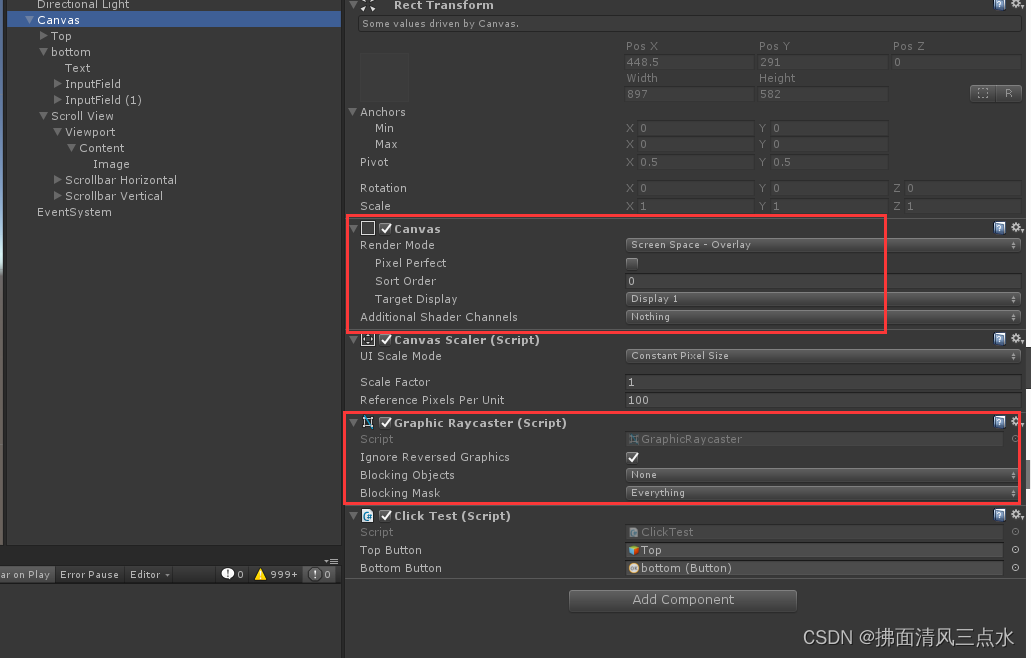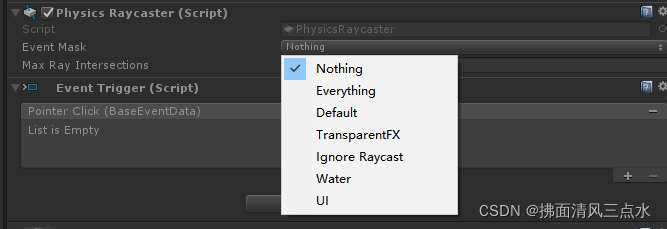Unity中的UGUI源码解析之事件系统(6)-RayCaster(下)
接上一篇文章, 继续介绍投射器.
GraphicRaycaster
GraphicRaycaster继承于BaseRaycaster, 是BaseRaycaster具体实现类, 是针对UGUI元素的投射器, 需要对象上同时存在Canvas组件.
值得一提的是, GraphicRaycaster和PhysicsRaycaster还有Physics2DRaycaster存放的目录不同, 后面两个放在EventSystem目录下, 而GraphicRaycaster放在UI目录下, 可能作者想要表面GraphicRaycaster只是针对UI使用的意思.
GraphicRaycaster主要依靠RectTranform相关的矩形框来射线检测, 基本不依靠摄像机.
通常我们添加一个Canvas时, 同时默认会添加上此组件. 如图:

面板属性
- Ignore Reversed Graphics: 忽略图形背面(默认勾选), 通过点乘判断射线是否从背面穿透, 如果勾选, 则背面不加入射线投射
- Blocking Objects: 阻挡射线对象类型, 也就是说射线遇到指定类型的物体就会被阻挡, 无法向下传递
- None: 默认不阻挡
- Two D: 2D物体阻挡, 这里的2D物体指的是
GameObject->2D Object菜单里面的物体, 同时需要物体上有2D的碰撞盒子(2D Collider) - Three D: 3D物体阻挡, 这里的3D物体指的是
GameObject->3D Object菜单里面的物体, 同时需要物体上有3D的碰撞盒子(3D Collider) - All: Two D + Three D
- Block Mask: 阻挡掩码, 也就是某些层级(Layer)的物体参与阻挡, 默认是所有的层级
- 上面所说的阻挡, 都是在阻挡的一层要有对应事件的处理器(也就是2D或者3D的Collider)
下面是相关的代码.
[AddComponentMenu("Event/Graphic Raycaster")]
[RequireComponent(typeof(Canvas))]
public class GraphicRaycaster : BaseRaycaster
{
protected const int kNoEventMaskSet = -1;
public enum BlockingObjects
{
None = 0,
TwoD = 1,
ThreeD = 2,
All = 3,
}
[FormerlySerializedAs("ignoreReversedGraphics")]
[SerializeField] private bool m_IgnoreReversedGraphics = true;
[FormerlySerializedAs("blockingObjects")]
[SerializeField] private BlockingObjects m_BlockingObjects = BlockingObjects.None;
public bool ignoreReversedGraphics { get {return m_IgnoreReversedGraphics; } set { m_IgnoreReversedGraphics = value; } }
public BlockingObjects blockingObjects { get {return m_BlockingObjects; } set { m_BlockingObjects = value; } }
[SerializeField]
protected LayerMask m_BlockingMask = kNoEventMaskSet;
private Canvas m_Canvas;
}
属性, 字段和方法
//---------------------------------------------------------
// 重写了BaseRaycaster的排序属性
public override int sortOrderPriority
{
get
{
// 如果Canvas的渲染模式为:ScreenSpaceOverlay, 也就是说总是保持在屏幕最上层, 则使用画布的渲染层级在多个画布中排序
// We need to return the sorting order here as distance will all be 0 for overlay.
if (canvas.renderMode == RenderMode.ScreenSpaceOverlay)
return canvas.sortingOrder;
return base.sortOrderPriority;
}
}
public override int renderOrderPriority
{
get
{
// 同上
// We need to return the sorting order here as distance will all be 0 for overlay.
if (canvas.renderMode == RenderMode.ScreenSpaceOverlay)
return canvas.rootCanvas.renderOrder;
return base.renderOrderPriority;
}
}
//-----------------------------------------------------------------
// GraphicRaycaster主要依赖Canvas来进行各种操作
private Canvas m_Canvas;
private Canvas canvas
{
get
{
if (m_Canvas != null)
return m_Canvas;
m_Canvas = GetComponent<Canvas>();
return m_Canvas;
}
}
// 用于发射射线的摄像机
// 如果Canvas的渲染模式为:ScreenSpaceOverlay或者没有指定摄像机则使用屏幕空间
public override Camera eventCamera
{
get
{
if (canvas.renderMode == RenderMode.ScreenSpaceOverlay || (canvas.renderMode == RenderMode.ScreenSpaceCamera && canvas.worldCamera == null))
return null;
return canvas.worldCamera != null ? canvas.worldCamera : Camera.main;
}
}
射线投射
接下来是重点和最复杂的地方.
[NonSerialized] static readonly List<Graphic> s_SortedGraphics = new List<Graphic>();
// 向给定graphic投射射线, 收集所有被射线穿过的graphic
private static void Raycast(Canvas canvas, Camera eventCamera, Vector2 pointerPosition, IList<Graphic> foundGraphics, List<Graphic> results)
{
int totalCount = foundGraphics.Count;
for (int i = 0; i < totalCount; ++i)
{
Graphic graphic = foundGraphics[i];
// ----------------------------
// -- graphic相关过滤条件
// depth==-1代表不被这个Canvas处理, 也就是绘制
//
if (graphic.depth == -1 || !graphic.raycastTarget || graphic.canvasRenderer.cull)
continue;
if (!RectTransformUtility.RectangleContainsScreenPoint(graphic.rectTransform, pointerPosition, eventCamera))
continue;
// ----------------------------
// z值超过摄像机范围则忽略, 所以可以通过指定z值来脱离射线投射
if (eventCamera != null && eventCamera.WorldToScreenPoint(graphic.rectTransform.position).z > eventCamera.farClipPlane)
continue;
// 射线是否穿过graphic
if (graphic.Raycast(pointerPosition, eventCamera))
{
s_SortedGraphics.Add(graphic);
}
}
// 深度从大到小排序
s_SortedGraphics.Sort((g1, g2) => g2.depth.CompareTo(g1.depth));
// StringBuilder cast = new StringBuilder();
totalCount = s_SortedGraphics.Count;
for (int i = 0; i < totalCount; ++i)
results.Add(s_SortedGraphics[i]);
// Debug.Log (cast.ToString());
s_SortedGraphics.Clear();
}
// [public]向给定graphic投射射线, 收集所有被射线穿过的graphic
[NonSerialized] private List<Graphic> m_RaycastResults = new List<Graphic>();
public override void Raycast(PointerEventData eventData, List<RaycastResult> resultAppendList)
{
if (canvas == null)
return;
// 收集canvas管理的所有graphic
var canvasGraphics = GraphicRegistry.GetGraphicsForCanvas(canvas);
if (canvasGraphics == null || canvasGraphics.Count == 0)
return;
int displayIndex;
var currentEventCamera = eventCamera; // Propery can call Camera.main, so cache the reference
// 根据canvas的渲染模式, 选择targetDisplay
if (canvas.renderMode == RenderMode.ScreenSpaceOverlay || currentEventCamera == null)
displayIndex = canvas.targetDisplay;
else
displayIndex = currentEventCamera.targetDisplay;
// 获取屏幕坐标, 支持多屏输出
var eventPosition = Display.RelativeMouseAt(eventData.position);
if (eventPosition != Vector3.zero)
{
// 根据屏幕坐标获取targetDisplay
// We support multiple display and display identification based on event position.
int eventDisplayIndex = (int)eventPosition.z;
// 抛弃非当前targetDisplay
// Discard events that are not part of this display so the user does not interact with multiple displays at once.
if (eventDisplayIndex != displayIndex)
return;
}
else
{
// The multiple display system is not supported on all platforms, when it is not supported the returned position
// will be all zeros so when the returned index is 0 we will default to the event data to be safe.
eventPosition = eventData.position;
// We dont really know in which display the event occured. We will process the event assuming it occured in our display.
}
// 转换视口坐标
// Convert to view space
Vector2 pos;
if (currentEventCamera == null)
{
// Multiple display support only when not the main display. For display 0 the reported
// resolution is always the desktops resolution since its part of the display API,
// so we use the standard none multiple display method. (case 741751)
float w = Screen.width;
float h = Screen.height;
if (displayIndex > 0 && displayIndex < Display.displays.Length)
{
w = Display.displays[displayIndex].systemWidth;
h = Display.displays[displayIndex].systemHeight;
}
pos = new Vector2(eventPosition.x / w, eventPosition.y / h);
}
else
pos = currentEventCamera.ScreenToViewportPoint(eventPosition);
// 抛弃视口之外的位置
// If it's outside the camera's viewport, do nothing
if (pos.x < 0f || pos.x > 1f || pos.y < 0f || pos.y > 1f)
return;
float hitDistance = float.MaxValue;
// 生成射线
Ray ray = new Ray();
// 使用相机生成
if (currentEventCamera != null)
ray = currentEventCamera.ScreenPointToRay(eventPosition);
// 2D和3D物体阻挡部分, 收集到投射距离, 代表被阻挡
if (canvas.renderMode != RenderMode.ScreenSpaceOverlay && blockingObjects != BlockingObjects.None)
{
float distanceToClipPlane = 100.0f;
if (currentEventCamera != null)
{
float projectionDirection = ray.direction.z;
distanceToClipPlane = Mathf.Approximately(0.0f, projectionDirection)
? Mathf.Infinity
: Mathf.Abs((currentEventCamera.farClipPlane - currentEventCamera.nearClipPlane) / projectionDirection);
}
// 使用反射获取PhysicsRaycaster的投射接口
if (blockingObjects == BlockingObjects.ThreeD || blockingObjects == BlockingObjects.All)
{
if (ReflectionMethodsCache.Singleton.raycast3D != null)
{
var hits = ReflectionMethodsCache.Singleton.raycast3DAll(ray, distanceToClipPlane, (int)m_BlockingMask);
if (hits.Length > 0)
hitDistance = hits[0].distance;
}
}
// 使用反射获取Physics2DRaycaster的投射接口
if (blockingObjects == BlockingObjects.TwoD || blockingObjects == BlockingObjects.All)
{
if (ReflectionMethodsCache.Singleton.raycast2D != null)
{
var hits = ReflectionMethodsCache.Singleton.getRayIntersectionAll(ray, distanceToClipPlane, (int)m_BlockingMask);
if (hits.Length > 0)
hitDistance = hits[0].distance;
}
}
}
// 收集所有被射线穿过的对象
m_RaycastResults.Clear();
Raycast(canvas, currentEventCamera, eventPosition, canvasGraphics, m_RaycastResults);
int totalCount = m_RaycastResults.Count;
for (var index = 0; index < totalCount; index++)
{
var go = m_RaycastResults[index].gameObject;
bool appendGraphic = true;
// 通过点乘判断背面是否参与投射
if (ignoreReversedGraphics)
{
if (currentEventCamera == null)
{
// If we dont have a camera we know that we should always be facing forward
var dir = go.transform.rotation * Vector3.forward;
appendGraphic = Vector3.Dot(Vector3.forward, dir) > 0;
}
else
{
// If we have a camera compare the direction against the cameras forward.
var cameraFoward = currentEventCamera.transform.rotation * Vector3.forward;
var dir = go.transform.rotation * Vector3.forward;
appendGraphic = Vector3.Dot(cameraFoward, dir) > 0;
}
}
//
if (appendGraphic)
{
float distance = 0;
if (currentEventCamera == null || canvas.renderMode == RenderMode.ScreenSpaceOverlay)
distance = 0;
else
{
// 抛弃在摄像机背面的对象
Transform trans = go.transform;
Vector3 transForward = trans.forward;
// http://geomalgorithms.com/a06-_intersect-2.html
distance = (Vector3.Dot(transForward, trans.position - currentEventCamera.transform.position) / Vector3.Dot(transForward, ray.direction));
// Check to see if the go is behind the camera.
if (distance < 0)
continue;
}
// 根据接触点判断是否抛弃对象
if (distance >= hitDistance)
continue;
// 封装投射结果
var castResult = new RaycastResult
{
gameObject = go,
module = this,
distance = distance,
screenPosition = eventPosition,
index = resultAppendList.Count,
depth = m_RaycastResults[index].depth,
sortingLayer = canvas.sortingLayerID,
sortingOrder = canvas.sortingOrder
};
resultAppendList.Add(castResult);
}
}
}
Graphic相关的内容我们将在后面的文章给出.
PhysicsRaycaster
当我们需要在3D物体上添加事件, 则需要场景中存在PhysicsRaycaster组件.
PhysicsRaycaster需要依靠摄像机进行射线检测. 除了射线检测部分外, 其它基本与GraphicRaycaster差不多.
面板属性
- Event Mask: 常用的mask, 和摄像机上的遮罩一样, 用于确定需要被检测的layer的物体, 会与摄像机做"位与"操作, 即参与检测的物体需要被摄像机"看到". 0代表"Nothing", -1代表"EveryThing"
- Max Ray Intersections: 最大射线击中数量, 也就是说, 这个数量确定了射线可以判断击中的物体数量, 默认是0, 代表无限制, 且这个版本是需要申请额外申请内存的(在非托管堆, C++层, 因为C#层无法预先知道数量), 而其它值不需要额外申请内存, 只需要在托管堆申请内存. 当然, 不能是赋值, 因为会用这个值来申请数组, 负值会报错.

下面是属性的相关代码, 使用部分在后面的检测中给出.
[AddComponentMenu("Event/Physics Raycaster")]
[RequireComponent(typeof(Camera))]
public class PhysicsRaycaster : BaseRaycaster
{
/// EventMask的默认值
protected const int kNoEventMaskSet = -1;
[SerializeField] protected LayerMask m_EventMask = kNoEventMaskSet;
/// 最大射线击中数量, 为0时代表不受限的数量, 会在非托管堆申请内存(c++), 其它正数会在托管堆申请(c#)
[SerializeField] protected int m_MaxRayIntersections = 0;
protected int m_LastMaxRayIntersections = 0;
/// 击中结果
RaycastHit[] m_Hits;
/// EventMask与摄像机按位与之后的结果
public int finalEventMask
{
get { return (eventCamera != null) ? eventCamera.cullingMask & m_EventMask : kNoEventMaskSet; }
}
/// EventMask属性
public LayerMask eventMask
{
get { return m_EventMask; }
set { m_EventMask = value; }
}
/// maxRayIntersections属性
public int maxRayIntersections
{
get { return m_MaxRayIntersections; }
set { m_MaxRayIntersections = value; }
}
/// 摄像机, 主要用于用于Mask确定检测的物体, 还有发射射线和计算起始点距离剪切平面的距离(clipPlane)
protected Camera m_EventCamera;
public override Camera eventCamera
{
get
{
if (m_EventCamera == null)
m_EventCamera = GetComponent<Camera>();
return m_EventCamera ?? Camera.main;
}
}
}
射线检测
大体思路是由摄像机发射射线, 并计算起始点距离剪切平面的距离, 供物理模块(Physic)进行射线检测.
根据最大射线击中数量调用物理模块不同接口返回击中结果.
下面是相关代码, C#部分:
// 发射射线并计算距离, 注意这个摄像机非常重要, 在不同的摄像机视角下判断击中的结果可能是不一样的
protected void ComputeRayAndDistance(PointerEventData eventData, out Ray ray, out float distanceToClipPlane)
{
ray = eventCamera.ScreenPointToRay(eventData.position);
// compensate far plane distance - see MouseEvents.cs
float projectionDirection = ray.direction.z;
// 如果发射点距离摄像机非常近, 则认为距离平面无限远
distanceToClipPlane = Mathf.Approximately(0.0f, projectionDirection)
? Mathf.Infinity
: Mathf.Abs((eventCamera.farClipPlane - eventCamera.nearClipPlane) / projectionDirection);
}
public override void Raycast(PointerEventData eventData, List<RaycastResult> resultAppendList)
{
// 抛弃摄像机viewRect之外的部分
// Cull ray casts that are outside of the view rect. (case 636595)
if (eventCamera == null || !eventCamera.pixelRect.Contains(eventData.position))
return;
Ray ray;
float distanceToClipPlane;
ComputeRayAndDistance(eventData, out ray, out distanceToClipPlane);
int hitCount = 0;
// ====================================================
// -- 根据最大射线击中数量调用物理模块不同接口返回击中结果
if (m_MaxRayIntersections == 0)
{ // 等于0, 代表接受不受限的击中物体
// 通过物理模块的检测所有物体的接口
// 底层是PhysicManager.RaycastAll
if (ReflectionMethodsCache.Singleton.raycast3DAll == null)
return;
// 返回击中结果
m_Hits = ReflectionMethodsCache.Singleton.raycast3DAll(ray, distanceToClipPlane, finalEventMask);
hitCount = m_Hits.Length;
}
else
{ // 非0, 代表接受有限的击中物体
// 通过物理模块的检测所有物体的接口
// 底层是PhysicManager.Raycast
if (ReflectionMethodsCache.Singleton.getRaycastNonAlloc == null)
return;
// 有限击中物体, 预先申请好最大击中结果, 如果两次数量一致则不需重新申请
if (m_LastMaxRayIntersections != m_MaxRayIntersections)
{
m_Hits = new RaycastHit[m_MaxRayIntersections];
m_LastMaxRayIntersections = m_MaxRayIntersections;
}
// 返回实际击中数量
hitCount = ReflectionMethodsCache.Singleton.getRaycastNonAlloc(ray, m_Hits, distanceToClipPlane, finalEventMask);
}
// ====================================================
// 根据距离从小到大排序(由近到远)
if (hitCount > 1)
System.Array.Sort(m_Hits, (r1, r2) => r1.distance.CompareTo(r2.distance));
// 返回检测结果
if (hitCount != 0)
{
for (int b = 0, bmax = hitCount; b < bmax; ++b)
{
var result = new RaycastResult
{
gameObject = m_Hits[b].collider.gameObject,
module = this,
distance = m_Hits[b].distance,
worldPosition = m_Hits[b].point,
worldNormal = m_Hits[b].normal,
screenPosition = eventData.position,
index = resultAppendList.Count,
sortingLayer = 0,
sortingOrder = 0
};
resultAppendList.Add(result);
}
}
}
C++部分(版权原因, 只贴部分代码):
// 数量不受限版本
const PhysicsManager::RaycastHits& PhysicsManager::RaycastAll (const Ray& ray, float distance, int mask)
{
// ....
// 会生成静态数组, 处于非托管堆, 无法释放
static vector<RaycastHit> hits;
// ....
RaycastCollector collector;
collector.hits = &hits;
GetDynamicsScene ().raycastAllShapes ((NxRay&)ray, collector, NX_ALL_SHAPES, mask, distance);
return hits;
}
// 数量受限版本(没有找到实现, 我自己猜的)
int PhysicsManager::Raycast (const Ray& ray, RaycastHit[] outHits, float distance, int mask)
{
// ....
vector<RaycastHit> hits;
RaycastCollector collector;
collector.hits = &hits;
GetDynamicsScene().raycastAllShapes((NxRay&)ray, collector, NX_ALL_SHAPES, mask, distance);
int resultCount = hits.size();
const int allowedResultCount = std::min(resultCount, outHitsSize);
for (int index = 0; index < allowedResultCount; ++index)
*(outHits++) = hits[index];
return allowedResultCount;
}
Physics2DRaycaster
Physics2DRaycaster继承于PhysicsRaycaster, 内容基本是都是一样的, 只是在选择物理模块时, 使用的2D的物理模块, 这里就只贴一下关键代码.
[AddComponentMenu("Event/Physics 2D Raycaster")]
[RequireComponent(typeof(Camera))]
public class Physics2DRaycaster : PhysicsRaycaster
{
public override void Raycast(PointerEventData eventData, List<RaycastResult> resultAppendList)
{
// ...
if (maxRayIntersections == 0)
{
if (ReflectionMethodsCache.Singleton.getRayIntersectionAll == null)
return;
// 用的接口不一样
m_Hits = ReflectionMethodsCache.Singleton.getRayIntersectionAll(ray, distanceToClipPlane, finalEventMask);
hitCount = m_Hits.Length;
}
else
{
if (ReflectionMethodsCache.Singleton.getRayIntersectionAllNonAlloc == null)
return;
if (m_LastMaxRayIntersections != m_MaxRayIntersections)
{
m_Hits = new RaycastHit2D[maxRayIntersections];
m_LastMaxRayIntersections = m_MaxRayIntersections;
}
// 用的接口不一样
hitCount = ReflectionMethodsCache.Singleton.getRayIntersectionAllNonAlloc(ray, m_Hits, distanceToClipPlane, finalEventMask);
}
// ...
}
}
总结
今天介绍了Unity几种射线投射器, GraphicRaycaster, PhysicsRaycaster, Physics2DRaycaster.
值得注意的是, 物理相关的两个投射器需要被投射的物体身上有对应的碰撞体(Collider和Collider2D), 不需要任何父子关系, 只要在场景中被摄像机看到即可进行投射. 而GraphicRaycaster主要使用Canvas来进行投射而不是摄像机, 被投射的物体必须是Canvas或者其子节点.
在分析过程中还发现, 原来Unity的3D物理引擎用的是"NVIDIA PhysX", 而2D物理引擎用的是"Box2D", 我之前一直以为是Unity自己写的呢.
可能是最新写的文章比较深, 我发现很多同学不怎么喜欢看, 我原来认为一开始就玩Unity的同学对底层的追求感不是那么强烈, 看来这个感觉没错.
从我个人的角度出发, 还是建议大家在愉快的用Unity开发游戏时能够抽时间研究研究底层, 因为对原理的理解很多时候能够让我们少走弯路, 同时最后也能走的更远.
接下来就是事件系统的最后一部分了, 也就是最核心的输入模块, 我会用几篇文章来详细介绍.
总之大家按需获取吧, 今天就是这样, 希望对大家有些许帮助.